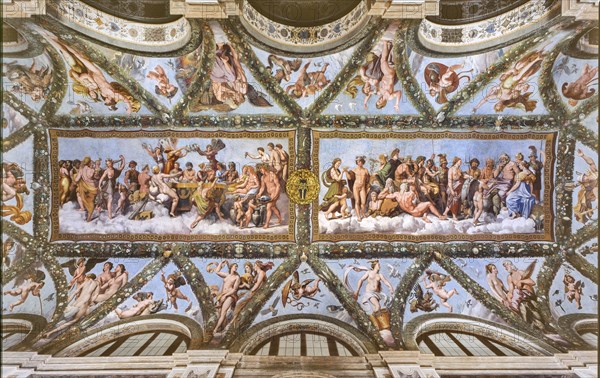
Sujet
Rome, Villa Farnesina, Loggia of Cupid and Psyche: view of the vault
Légende
Roma, Villa Farnesina, Loggia di Amore e Psiche: veduta della volta.
Al centro del complesso sistema figurativo spiccano le grandi rappresentazioni del Concilio degli dei e del Convito nuziale, (di Amore e Psiche) tra finti arazzi tesi tra festoni. Nei peducci si trovano i vari episodi delle Storie di Amore e Psiche. Nelle vele sopra le lunette putti con gli attributi delle varie divinità.
Gli affreschi (1917-18) sono opera di Raffaello e dei suoi allievi (Raffaellino del Colle, Giovan Francesco Penni, Giulio Romano, Giovanni da Udine). Gli affreschi vennero sicuramente disegnati da Raffaello, ma la stesura spetta soprattutto alla sua scuola. La presenza degli intrecci vegetali accresce il senso di continuum della loggia con il giardino; vi sono riconoscibili la bellezza di circa duecento specie botaniche, soprattutto domestiche, tra cui anche numerose piante importate dalle Americhe, scoperte solo pochi anni prima.
[ENG]
Rome, Villa Farnesina, Loggia of Cupid and Psyche: view of the vault.
In the centre, two fictive tapestries include the concluding scenes: the splendid Council of the Gods, where the unjustly persecuted girl is finally received by the gods with divine complacence, and the Marriage of Cupid and Psyche, the symbolic culmination of the entire cycle.
The Loggia takes its name from the decoration frescoed on the vault by Raphael and his workshop in 1517-18. The frescos represent episodes from the fable of Psyche, narrated in Apuleiu’s Golden Ass, which had already been used in the fifteenth century for nuptial imagery.
To give the space a festive and theatrical feel to it, Raphael also transformed the vault of the Loggia into a pergola, adorned with magnificent hanging festoons, as though the greenery of the gardens had invaded the Villa itself.
However, although the general layout of the cycle and planning of the individual scenes and figures are attributed to the intuitive genius of Raphael (proven by a number of autographic sketches), the actual completion of the designs into frescos was carried out by his numerous workshop assistants, including Giovanni Francesco Penni, Giulio Romano and Giovanni da Udine. The latter, in particular, was the creator of the exuberant triumphal festoons.
Villa Farnesina, Roma/Rome, Lazio, Italia/Italy
Date
19 sept. 2015
Crédit
Ghigo Roli/Photo12
Notre référence
GHR20A07_359
Licence
Droits gérés
Format disponible
251,7Mo (19,3Mo) / 100,0cm x 63,1cm / 11811 x 7449 (300dpi)
Mots clés
Loggia Détail architectural Jardinage paysager Fresque Amour Psyché et l'Amour Apulée Architecture Art Artiste Banchetto Festin Aliment Nourriture Dieux grecs Divinité Bâtiment Fioriture Fleuri Fleur Fleur Fruit Jardin Jules Romain Cinquecento 16e siècle Italie L'Asino d'Oro L'Âne d'or Latium Mariage Métamorphoses Mythe latin Mythologie Noces Olympe Œuvre d'art Peinture Raffaellino del Colle Raphaël Rome Villa Demeure Villa Farnèse 16e siècle Loggia
Restrictions
Pour toute utilisation, il revient à l'utilisateur de s'assurer qu'il a toutes les autorisations nécessaires des entités représentant les artistes ou leurs ayants droit.